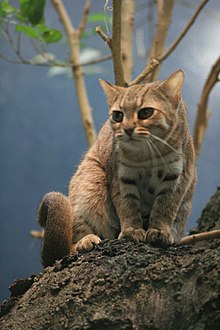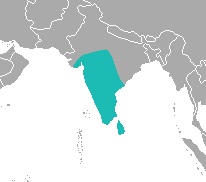Rusty-spotted cat
| Rusty-spotted cat | |
|---|---|
 |
|
| Scientific classification | |
| Kingdom: | Animalia |
| Phylum: | Chordata |
| Class: | Mammalia |
| Order: | Carnivora |
| Family: | Felidae |
| Genus: | Prionailurus |
| Species: | P. rubiginosus |
| Binomial name | |
|
Prionailurus rubiginosus Geoffroy Saint-Hilaire, 1831 |
|
 |
|
| Rusty-spotted cat range | |
The rusty-spotted cat (Prionailurus rubiginosus) is one of the cat family's smallest members, of which historical records are known only from India and Sri Lanka. More recently, it was also recorded in the western Terai of Nepal. Since 2016, the global wild population is listed as Near Threatened on the IUCN Red List as it is fragmented and affected by loss and destruction of prime habitat, deciduous forests.
The rusty-spotted cat is the smallest wild cat in Asia and rivals the black-footed cat as the world's smallest wild cat. It is 35 to 48 cm (14 to 19 in) in length, with a 15 to 30 cm (5.9 to 11.8 in) tail, and weighs only 0.9 to 1.6 kg (2.0 to 3.5 lb). The short fur is grey over most of the body, with rusty spots over the back and flanks, while the underbelly is white with large dark spots. The darker colored tail is thick and about half the length of the body, and the spots are less distinct. There are six dark streaks on each side of the head, extending over the cheeks and forehead.
The rusty-spotted cat has a relatively restricted distribution. It mainly occurs in moist and dry deciduous forests as well as scrub and grassland, but is likely absent from evergreen forest. It prefers dense vegetation and rocky areas.
Two subspecies are recognized:
In India, it was long thought to be confined to the south, but records have established that it is found over much of the country. It was observed in the Gir Wildlife Sanctuary and National Park, in the Tadoba-Andhari Tiger Reserve in Maharashtra, on India's east coast, and in eastern Gujarat.Camera trapping revealed its presence in the Pilibhit Tiger Reserve in the Indian Terai and in the Nagzira Wildlife Sanctuary in Maharashtra. In western Maharashtra, there is a breeding population of rusty-spotted cats in a human dominated agricultural landscape, where rodent densities are high. In December 2014 and in April 2015, it was photographed by camera traps in Kalesar National Park, Haryana.
...
Wikipedia

